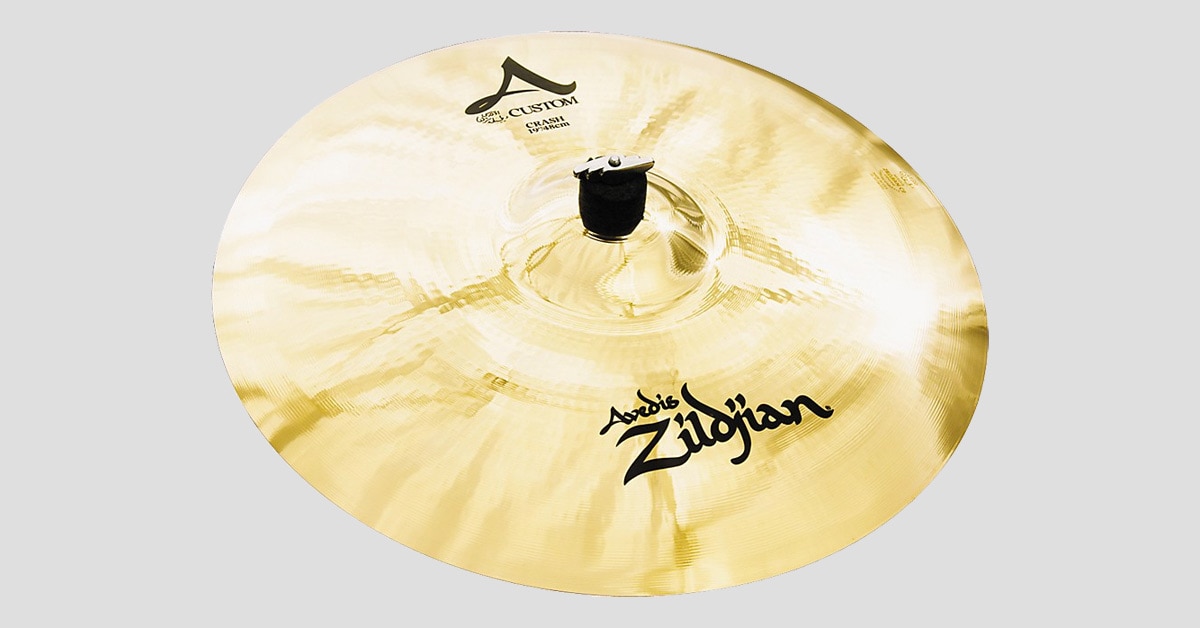A drum kit without a set of worthy cymbals is like a plate of french fries without the salt and ketchup. Cymbals add seasoning and tonal color to your drumming. In this guide we’ll help you figure out what cymbals are right for your music, drum set, and budget.
Table Of Contents
What’s The Right Complement Of Cymbals For You?
Anatomy Of A Cymbal
How Cymbals Are Made
A Cymbal For Every Role In The Drum Set
Ride Cymbals
Hi-Hats
Crash Cymbals
Splash Cymbals
China And Effect Cymbals
Cymbal Packs—An Affordable Option
Summing Up
What’s The Right Complement Of Cymbals For You?
There’s no snap answer to that question. The music you play and the budget you’ve got to play with should be primary considerations. And in the end, your ears should be the deciding factor. The cymbals you select should be pleasing to your musical tastes and fit in sonically with the rest of your drum kit.
Jazz drummers are probably going to want very different cymbal arrays than those that suit drummers in metal or hard rock bands. A good place to get started is by checking out the cymbal setups of your favorite drummers. You may not be able to replicate every element of their cymbal choices, but you’ll get important clues on what does and doesn’t work in the context of the music they play.
Once you’ve identified the right cymbal types and sizes for your drum kit, you can proceed to shop for the models that match up with your budget. As with most things, you get what you pay for when buying cymbals. Premium cymbals are made with more costly materials and involve more hand work. That said, lower-priced cymbals can still deliver surprisingly satisfying sound—there are some real bargains to be found among budget cymbals.
Anatomy of a Cymbal
All cymbals intended for use with a drum set are of the suspended type—that is, they’re designed to be mounted on stands that are either free standing or attached to drum kit components such as the bass drum. A hole is drilled in the center of the cymbal to allow mounting the cymbal to a stand. Most cymbals have a raised center portion referred to as the bell, cup, or dome. Playing the bell produces a higher “pinging” tone than the rest of the cymbal. The remainder of the cymbal is called the bow. Cymbals with a pronounced taper in thickness from the bell to its thinner edge may be described as having ride and crash areas. The thicker portion closest to the bell is called the ride area; the thinner, outer portion is the crash area.
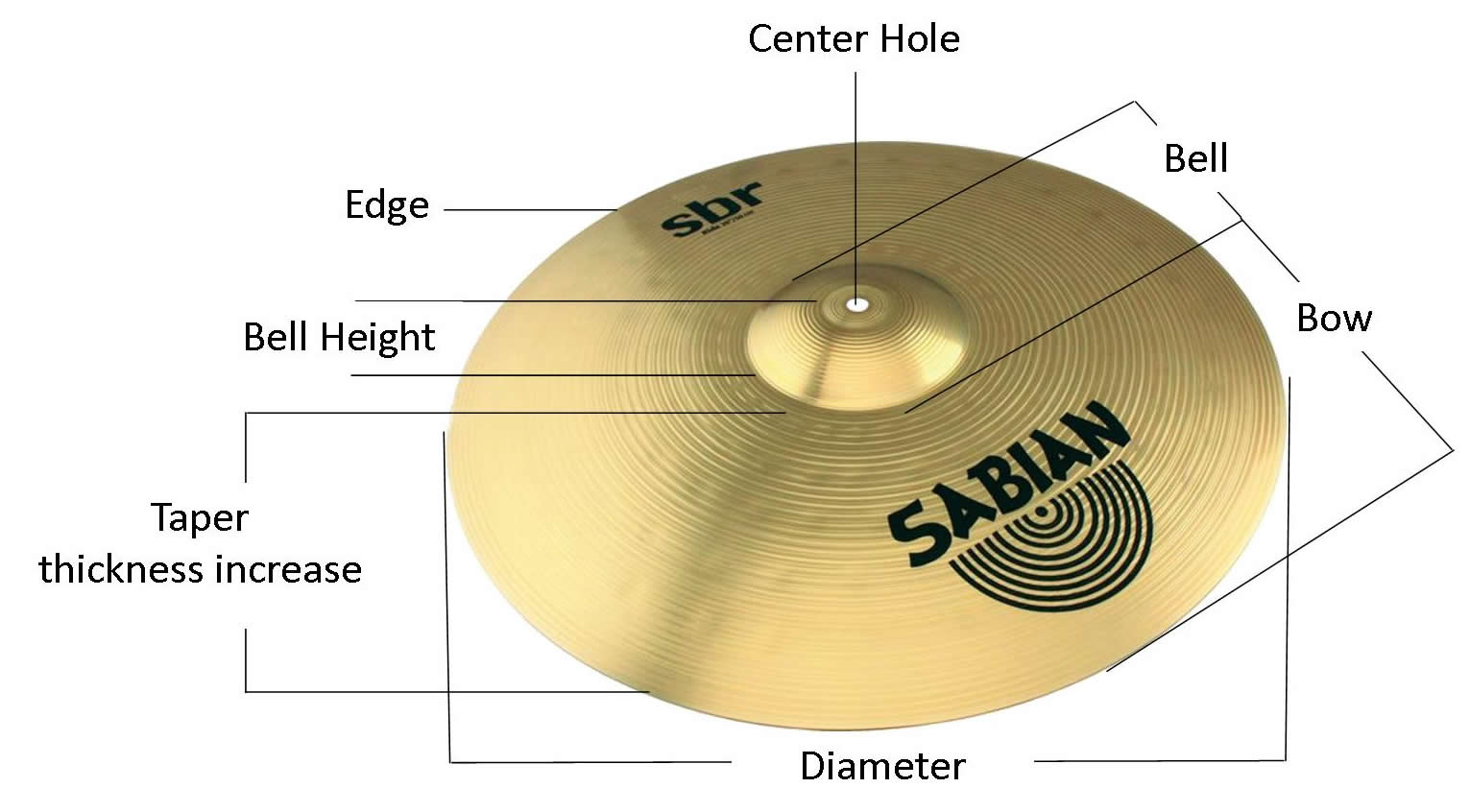
Cymbal sizes are designated by their diameter in inches or millimeters. Generally speaking, larger cymbals are louder and have longer sustain. Thinner cymbals tend to have a lower pitch and respond faster. Thicker, heavier cymbals produce greater volume, and thanks to their greater articulation when struck with a drumstick, cut through dense sound mixes better.
How Cymbals Are Made
Most cymbals are either cast or made from sheets of metal.
Cast cymbals are made by pouring raw, molten metal alloys into circular molds. The castings are then heated, rolled, shaped, hammered, and lathed. This lengthy process results in cymbals with a full, complex sound that many feel improves with age. Each cast cymbal has a distinct sonic character that is unique.
The term “hand-hammered” can be deceptive. The finest cymbals are hammered by a craftsman who actually wields a hammer, applying the hammering one blow at a time. Less costly cymbals may be hammered by a worker using a machine. Truly hand-hammered cymbals tend to produce richer, darker, lower-pitched tones and vary more from one cymbal to the next. Machine-hammered cymbals are typically brighter, producing higher tones that cut more sharply through the mix. They also tend to vary less in sound from one cymbal to the next.
Some cymbals are turned on a lathe to impart certain sonic characteristics. Lathing can be done on either the top or bottom surface or both. Many cymbals have bands that are lathed and unlathed offering more tonal options depending on what part of the cymbal is played.
Sheet metal cymbals are cut from large sheets of metal of uniform thickness and composition. They have a very uniform sound from cymbal to cymbal within the same model, and are generally less expensive than cast cymbals. Some lower-cost student cymbals have lathe and hammering marks pressed into their surface.
You’ll find cymbals with various polish or finish treatments. Cymbals that are fully lathed often have a clear lacquer finish to prevent tarnishing. Some models have “brilliant” or “bright” finishes that are achieved with high-speed buffing. The buffing process can actually dull the sound slightly while contributing an attractive gleam to the cymbals.
Cymbal sounds are a very individual preference. Many jazz players favor darker, more complex cymbal sounds, while rock drummers generally lean toward a brighter, louder sound that cuts through the mix. While a few traditional cymbal-manufacturing giants continue to dominate the market, there's an expanding universe of options to choose from.
A Cymbal For Every Role In The Drum Set
As we’ll see below, each cymbal type is designed to fulfill a specific role in the modern drum kit. But rules are made to be broken. Many drummers use unconventional mixtures of cymbals to achieve distinct sounds of their own. Experimenting with other drummers’ cymbals as well as the placement of your own cymbal setup can lead to some interesting sonic effects.
Ride Cymbals
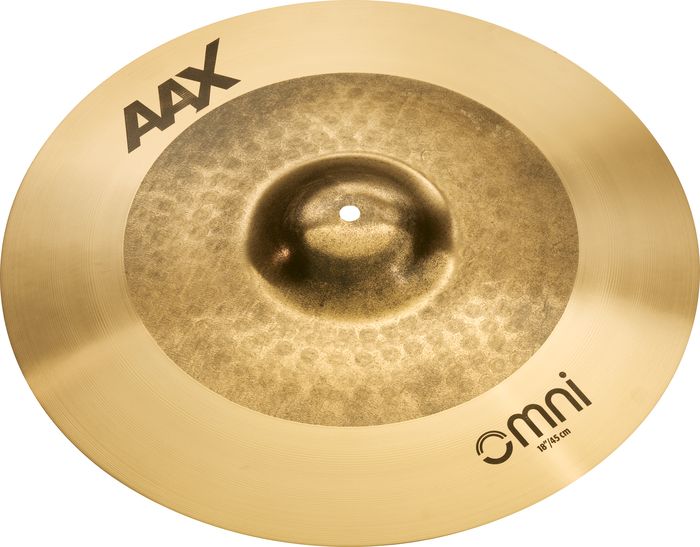
Sabian’s AAX Omni Ride makes a great hybrid crash-ride.
The ride cymbal holds down a steady groove in most drumming styles. Typically, its placed at the drummer’s extreme right (assuming he or she is right-handed). Its name is derived from the role it plays, providing a steady, overriding pattern. While cymbal makers produce specific ride models, some drummers use effects cymbals such as chinas, pangs, and sizzle cymbals instead. Again, rules are made to be broken where cymbals are concerned.
You’ll also come across cymbals designated as crash/rides that offer a prolonged, slow crash. They’re sometimes used as the only suspended cymbal in small drum sets. Another variation are flat ride cymbals that lack the usual bell. Flat rides have a dry crash and are popular among jazz drummers.
Hi-Hat Cymbals
The hi-hats are usually played in conjunction with the bass and snare drums in performance. Consisting of two cymbals mounted together on a stand and operated by a pedal that opens and closes the pair, the hi-hat produces what’s called a “chick” sound when it’s struck by a stick or clashed using the pedal. Drummers control the sound and sustain of the hi-hats by using various pedal positions and varying the amount of foot pressure applied.
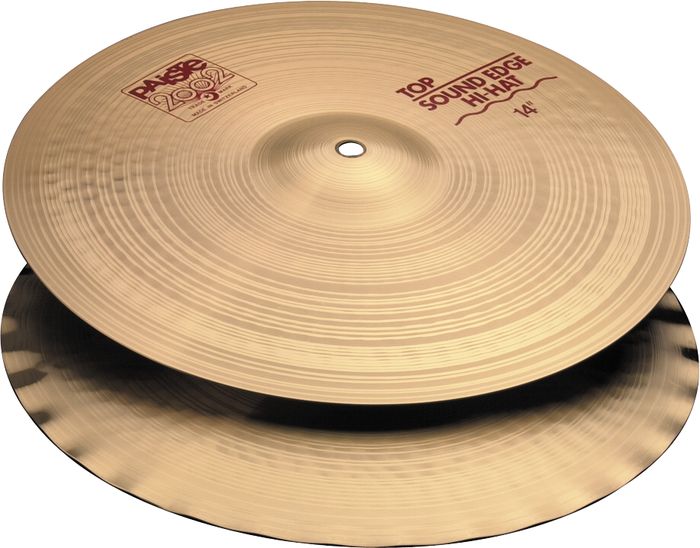
Paiste 2002 Sound Edge Hi-Hats have a rippled bottom to prevent air lock and produce a sharp “chick” sound.
One of the drumming patterns associated with the hi-hats is the shuffle. To create a shuffle beat, the drummer hits the top cymbal twice in close succession, the first time with the hats closed, and just before the second strike allows the hats to open. The drummer lets the cymbals ring momentarily before closing them again to produce a chick and thus completes the pattern. The shuffle is just one of dozens of techniques that can be used to produce rhythms and counter rhythms.
While a 14” pair of hi-hats is the modern norm, smaller diameters are sometimes used in recording when close-miking is used. Hard rock drummers such as the late, great John Bonham sometimes use bigger 15” hats. In the past, the two cymbals were similar, but today the trend is towards heavier bottom and lighter top cymbals. There are exceptions though. Steve Gadd’s Zildjian K Custom Session hats for example place the heavier cymbal on top for a crisp chick. Other drummers use mismatched cymbals of different sizes or even from different cymbal families and brands. Again, there are no rules; as with all the cymbals in a drum kit, no one size fits all.
Crash Cymbals
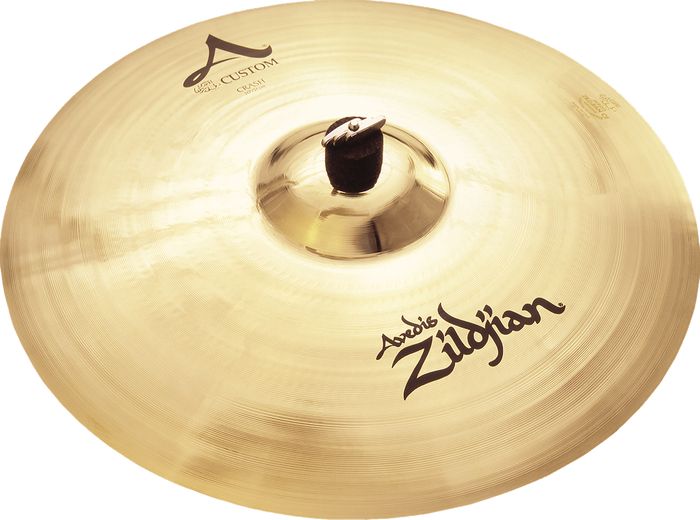
The Zildjian A Custom Crash offers bright, natural sound with complex overtones.
The crash is typically used to create loud, defined accents as opposed to playing a steady rhythm. Most modern kits usually have at least one or two crash cymbals. They can be played with sticks, your hands, or mallets to produce a wide range of tonal colors. Rock drummers sometimes hit two crashes at the same for an extra-powerful accent. You’ll find crash cymbals in a range of thicknesses and sizes running from as small as 8” up to 24” with the majority falling in the 14”-18” range. While most have a fairly thin edge, the thickness of crashes varies substantially. Hard rock and metal drummers tend to favor thicker crashes.
Splash Cymbals

Zildjian A Splash has a pure, bright, and expressive voice.
Splashes are the smallest accent cymbals, typically ranging in size between 6”-13”. The splash cymbal was popular with jazz drummers in the 1920s and 1930s, but fell out of favor. They were revived largely by Police drummer Stewart Copeland, and heavier splashes suited to rock soon appeared. China-type cymbals with a diameters under 14” are sometimes referred to as china splashes, though this designation varies with manufacturers.
Today you’ll find a wide range of splashes including the so-called salsa splash that’s intended for use with timbales. Bell splashes are very thick and produce a bell-like sound; they come in a variety of shapes. Some splashes are designed to be used in stacks with other cymbals and sometimes come in sets. Mounts for splashes are as varied as the cymbals themselves.
China And Effects Cymbals
The china cymbal’s name originates with its visual and sonic similarities to Chinese gongs. The typical china bell is cone-shaped and is turned up at its edge where the bell meets the cymbal’s bow. Most chinas have little or no taper to their thickness, but there are exceptions to all these physical generalities. Chinas usually range between 12”-26” in diameter. The thing that most defines a china is its sound that’s usually described as dark, trashy, and explosive.
As with chinas and splashes, which are often considered types of effects cymbals, the exact definition for effects cymbals is elusive. Generally speaking, they’re used in non-rhythmic ways to provide bursts of tonal color and accents. When pang and swish cymbals—two types of effect cymbals—are used in place of a traditional ride, they are usually not thought of as effects cymbals any longer.
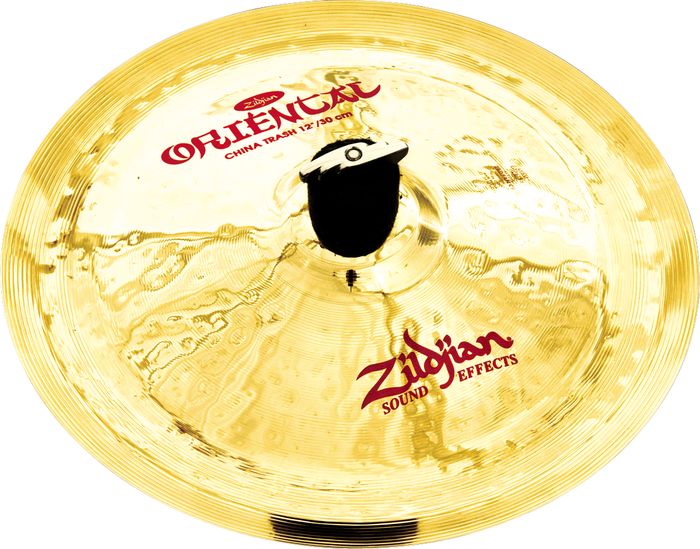
Zidjian’s Oriental China Trash cymbal has explosive response with rapid decay.
Effects cymbals come in a dizzying range of variations. You’ll find models with holes and rivets that create intensely loud, buzzing and cutting effects. And there are countless more designs out there to create an amazing array of sounds. The sky’s the limit when it comes to their designs and sounds.
Cymbal Packs—An Affordable Option
Many manufacturers offer complete cymbal assortments at very affordable prices. They’re sometimes bundled according to the type of music they’re intended for, with rock cymbal packs being a very common offering. The component cymbals in these packs are carefully matched to be sonically complementary to each other. Cymbal packs are a budget-friendly way for the beginning drummer to gear up.
Summing Up
By now you should have a pretty good idea of the key considerations when shopping for cymbals. Keep in mind that the thousands of customer-written product reviews from fellow drummers you’ll find on Musician's Friend’s website can be invaluable in helping whittle down the possibilities.
We want you to be pleased with your cymbal purchase, and offer a 100% satisfaction guarantee and generous return policy so you can order with confidence.
After reading this guide, if you’re still not sure which cymbals are right for you, we invite you call to one of our friendly and knowledgeable Gear Heads.
To learn more about cymbals and their place in the drum set, read our Drums Buying Guide and our Electronic Drums Buying Guide.





































































































































